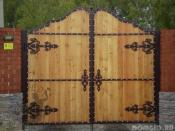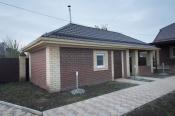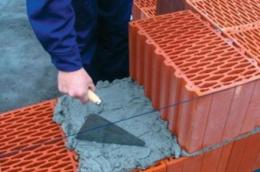Search
Login
Warm mortar, warm mortar for laying ceramic blocks
Although ceramic blocks appeared relatively recently in the field of private housing construction, they have already managed to obtain the status of promising and high-tech material. The hollowness of the structure provides a low level of thermal conductivity, which gave reason to assign the blocks the second name of warm ceramics. Like all materials for walling, ceramic blocks require installation, it is performed quite traditionally - with the help of masonry. Only here it is advisable to use a special, warm mixture for masonry.
Content:
- Warm solution for ceramic blocks - basic propertiesvideo
- Features of the preparation of warm masonry mortar video
- Criteria for choosing a composition for preparing plaster video
Warm solution for ceramic blocks - basic properties
Since ceramic blocks are heat-saving material, to obtain a masonry with low thermal conductivity, it will be necessary to use special mixtures, the mandatory addition of which can be light porous substitutes, such as:
- vermiculite
- pumice,
- perlite, which are quite effective heat insulators.
For masonry ceramic blocks using a warm solution, the composition of which is as follows:
- portland cement - as a binder component,
- additives of polymer origin - to improve the plasticity of the finished mixture, accelerate its solidification, increase frost resistance, water resistance,
- porous fillers.

The area of \u200b\u200buse of warm masonry mortars is quite extensive, except for the laying of ceramic hollow blocks it is used in the construction of houses from aerated concrete blocks and large-format blocks from cellular concrete. The properties of the warm solution allow him to emphasize all the advantages of these wall materials.
advantages
High-quality masonry completely eliminates the possibility of cold bridges, increasing resistance to the heat transfer process by about 30%. In addition, lightweight fillers make it possible to minimize the pressure exerted by the walls on the foundation. Considerable savings can be obtained by reducing the consumption of masonry material.
Due to the high water-holding abilities of the warm solution, it is possible to use it in masonry using thin-walled technology. Filling the joints in the masonry with a solution having a low thermal conductivity can significantly reduce the amount of heat flux penetrating the masonry and reduce their speed.

However, the warm solution is permeable to vapors, i.e. allows you to maintain optimal humidity characteristics for the person in the house, condensate on the walls in such a room will not settle. Thanks to the use of warm masonry mixtures, the owners of the house will not be threatened by the appearance on the walls of fungal and mold crops.
Naturally, the owners of the premises will receive savings on the maintenance of the house and its heating in the winter.
The consumption of warm mortar for ceramic blocks will be about 1.75 times less than conventional sand-cement, due to the low density of the first.
Watch a video about the properties of a solution on perlite, its preparation and use:
Features of the preparation of warm masonry mortar
In most cases, a warm mortar is used when laying external walls; for internal walls, an ordinary sand-cement analogue is often used. They prepare a warm solution with their own hands or with a concrete mixer, if the volume is supposed to be large, it is best to rent a concrete mixer - the speed of work will increase significantly. You can prepare building dough from packaged ready-made mixtures - you just need to add water to them and then mix thoroughly. A standard package weighing 35 kg will produce about 31 liters of the finished solution.

If the components are bought separately, then first you will need to mix all the components in a dry form, only then you can add liquid.
In the manufacture of a warm solution, it is recommended to observe the following proportions:
- perlite cement binder is added perlite or expanded clay sand - 5 parts,
- 4 parts of the mixture in dry form will need to use 1 part of water.
Water should be used from a water supply system, mineral impurities in water from water bodies can affect the balance of the components of the prepared solution.
The consistency of the finished solution should be medium thick - very liquid will fill the voids of the blocks and reduce their thermal insulation characteristics. Before use, the solution should be allowed to stand for 5 minutes.

If you create a warm solution thick - it will lose its ability to provide reliable fastening - ceramic blocks absorb too much moisture - the solution will dry before it has time to gain strength. Excessively liquid solution will lead to an increase in material consumption - losses will increase due to the presence of voids in the blocks. The use of ready-made mixtures will avoid the need to wet the blocks - a warm solution is able to retain moisture for a sufficiently long period.
The best time to complete the construction is the warm season, low temperatures cause the mortar to set too quickly, which ultimately does not contribute to improving the quality of the masonry. Performing masonry at temperatures below +5 ° C, antifreeze additives should be added to the solution, but they also will not save the masonry from a decrease in strength.
Since perlite is the most popular of the binder heat-insulating materials, it is customary to replace sand with the preparation of the solution. Experts warn that such a composition should not be mixed in a concrete mixer for too long - perlite tends to granulate and form into tight lumps. Having received a homogeneous mass, the mixing process should be stopped.

When laying a private house, color can be added to the composition of the solution, this will increase the decorativeness of the masonry, tinting does not negatively affect the quality.
On how to properly prepare the masonry mortar, watch the video:
Criteria for choosing a composition for preparing plaster
In specialized construction stores today you can find dry warm masonry mixes from different manufacturers that differ in labeling. This is very convenient for buyers - you can choose the one that suits the specific building material and contains the desired percentage composition:
- thickener
- plasticizer
- modifiers.
In 10 kg of dry mix can be included from 150 to 200 g of various additives. Ultimately, the quality of the solution, its strength and adhesion determines the balance of the number of modifiers.

Of course, to use a warm solution for ceramic blocks, the price of which significantly exceeds the cost of a regular sand-cement, some may consider wasteful. Nevertheless, experts advise not to compromise and not to look for mixtures exclusively among cheap analogues - only manufacturers of warm ceramic blocks can usually guarantee the ideal quality of products. Spending the same funds without having the confidence that the product will allow you to get a fairly high performance masonry mortar, it makes no sense.

If it’s about saving money by using a regular sand-cement mixture, you will need to make it more dense in consistency, and soak the ceramic blocks before laying in water. Only this option will make it possible to obtain a strong and reliable masonry. The consumption in this case will decrease slightly, the amount of moisture absorbed by the ceramic block will also become smaller. To simplify the masonry process, it is recommended to add plasticizers to the mixture.
Experts advise: the thickness of the masonry joint from an ordinary mortar should not exceed 1-1.2 cm, otherwise cold bridges will form, therefore there will be heat loss.
Watch a video on how to build a warm house:
Of course, it is up to the owner of the house to decide whether to use warm mortar or ordinary to use when building a house. But does it make sense to save about 10% on the cost of walls, so that later during the entire period of operation you spend extra money on heating the house.






